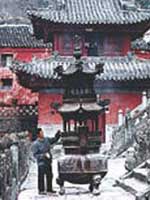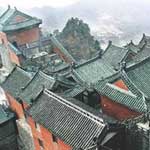 |
 |
|
Pilgrimage to Wudang
By Wang Fang (Beijing Today)
Updated: 2004-05-11 10:30
 Wudang Mountain, in the northwest of Hubei Province, is perhaps the best
known of China's Taoist holy mountains. It was listed by UNESCO as a World
Cultural Heritage Site in 1994. Wudang Mountain, in the northwest of Hubei Province, is perhaps the best
known of China's Taoist holy mountains. It was listed by UNESCO as a World
Cultural Heritage Site in 1994.
The
main tourist attractions, spread over an area of 300 square kilometers, compose
a spectacular panorama of traditional Chinese landscape painting.
Known
to locals as Taihe or Xuanyue, Wudang Mountain's beautiful scenery o tranquil
valleys juxtaposed with precipitous peaks offers three main areas of interest to
travellers.
Ancient Taoist temple complex
The oldest structures
date back to 1300, during the Tang Dynasty, and there are examples of
architecture from each subsequent dynasty; the Song, Yuan, Ming and Qing.
There are altogether 72 temples, 39 bridges, 36 nunneries and 12 pavilions,
a statistic that gave rise to the old saying, "a nunnery every ive miles and a
palace every mile." The oldest temple, Wulongci (Five Dragons Ancestral Temple)
represents the commencement of the promotion of Taoism, hence Wudang is known as
the cradle of Taoism. In 1413, Emperor Zhdi of the Ming Dynasty ordered 33
temples to be built within ten years, representing the peak of its development.
At twilight at Zixiaogong (Purple Clouds Palace),
Taoist monks can be seen walking in the empty square in front of the palace. The
master, Guo Gaoyi, a white whiskered and extremely healthy septuagenarian,
suggests measures for preserving health, "Practising is to train ourselves and
taking care is to protect ourselves. Thee are three kinds of treasure in the
universe; the sun, the moon and the stars. Humans also have three kinds of
treasure, the vigor, the breath and the spirit. It is important to know how to
use them appropriately."
In
Wudang Temple, the bell and the drum strike out the time. Every morning, the
monks get up at around 5 and assemble in the palace to read Taoist canons, to
the accompaniment of Taoist music, then do so again in the afternoon, also
singing Taoist songs. At Zixiaogong, there are statues of gods and immortals on
the altars, as well as sacred objects and musical instruments. This is where the
largest Taoist rite for the saving of the souls of the dead is performed.
“You must be a good person before becoming a Taoist,” is the often-heard
mantra at Wudang. Taoists should be compassionate, loyal and faithful. Only by
becoming a good person can one train oneselto become immortal, it is believed.
Wudang
kung fu
Wudang kung fu enjoys great popularity, both in China
and abroad. According to legend, Zhang Sanfeng, the originator of Wudang quan
(taiji) was inspired by a fight he witnessed between a pied magpie and a snake.
Wudang quan advocates the cultivation of morality and fostering of nature in
conjunction with physical training.
The film Crouching Tiger, Hidden
Dragon attracted students of kung fu travel from all over the world to study
with the masters at Wudang. Visitors to Wudang, if they are lucky, will see
masters practicing on the roofs of the halls and on the mountain.
The
Hall of Yuzhen is the cradle of Wudang kung fu. In 1417, Emperor Zhudi decreed
Wudang to be the "Grand Mountain" and ordered the construction of the Hall of
Yuzhen for Master Zhang Sanfeng.
On
January 19, 2003, a fire broke out in the hall, reducing the three rooms that
covered 200 square metres to ashes. A gold-plated statute of Zhang Sanfeng,
which was usually housed in Yuzhengong, was moved to another building just
before the fire, and so escaped destruction in the inferno.
Spectacular natural scenery
 On top of Nanyan
(South Rock) is a stone beam with a dragon carved on it protruding from above
the cliff, which attracts many travellers to burn incense on it as a sign of
their devotion. On top of Nanyan
(South Rock) is a stone beam with a dragon carved on it protruding from above
the cliff, which attracts many travellers to burn incense on it as a sign of
their devotion.
The Huanglongdong (Yellow Dragon Cave) is a cave
surrounded by Taoist temples and shrines on the way to Jinding (Golden Peak). It
is cool and damp, and said to be an ideal spot for meditation.
The
final ascent to Jinding is a zigzag stone staircase of 212 steps carved into the
mountain called Jiuliandeng (Nine Lotus Stairs). Standing on Jiuliandeng, the
summit appears to be near at hand, and the mountains surrounding Jinding all
seem to lean in towards it.
When
finally arriving at the top, visitors go through a dark hall called Zhuanyundian
(Changing the Fate Palace). Taoists rap on a wooden fish, asking, "have you
turned round?" The reply, "Yes, I have," implies that their fate has changed.
Upon stepping out of the dark hall, the contrng sunshine is said to symbolize
the experience of nirvana and a new life ahead.
Do's and don’ts:
Step over, not on the thresholds of Taoist temples.
Do not point
at or turn your back to statues of the gods.
There is an old saying in
China, "(Buddhist) monks don't tell their names and Taoists don't tell their
age." Do not ask the monks how old they are.
If you go
hiking on the mountain, find a local guide and do not stray too far from the
main path.
Tip:
The best times to visit are spring and autumn.
Getting there:
Take a train to Wuhan
and then transfer to the Wudang Mountain Tourists Train, or take the train from
Beijing to Xiangfan and then transfer to Wudang.
Alternatively, fly to
Laohekou Airport at Xiangfan. China United flight CUA307 departs Beijing at 8 am
Wednesdays (580 yuan). From Laohekou, it is 90 kilometers by bus to
Wudang.
|
|
| |
Story
Tools |
|
 |
| |
|
|
|
 |
 |
|